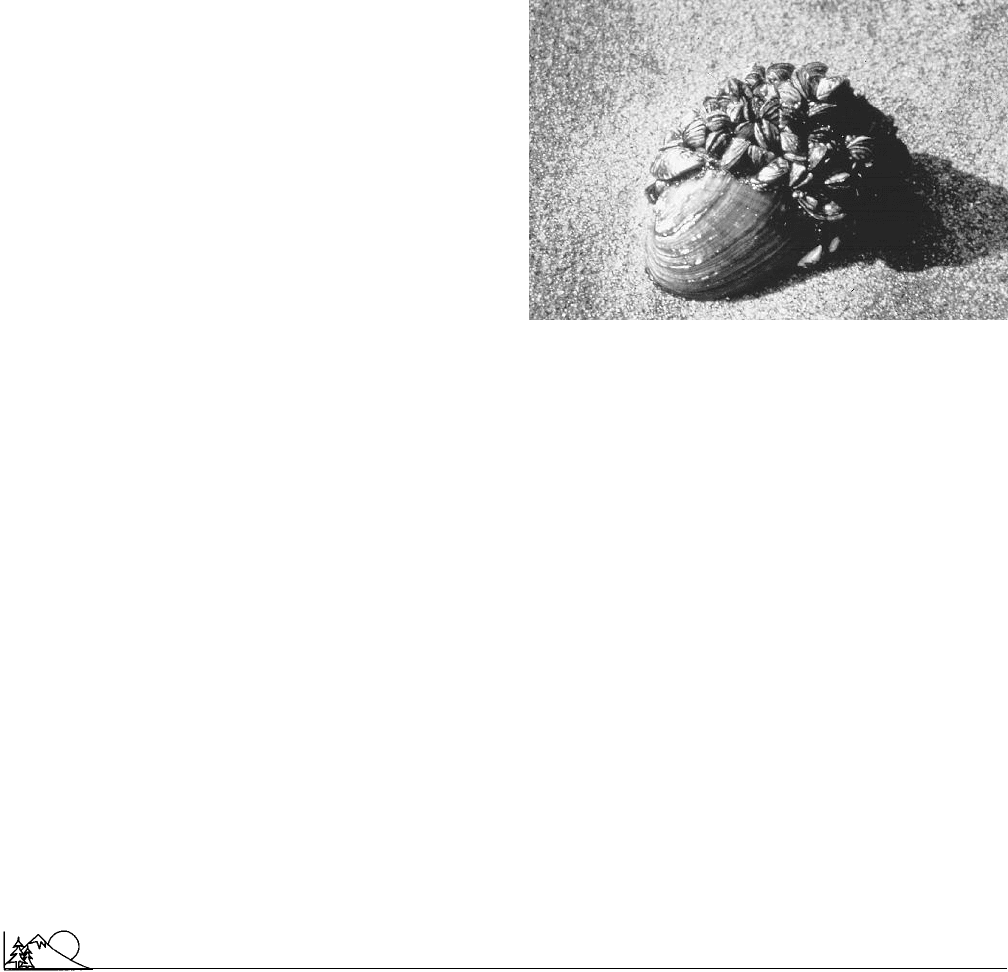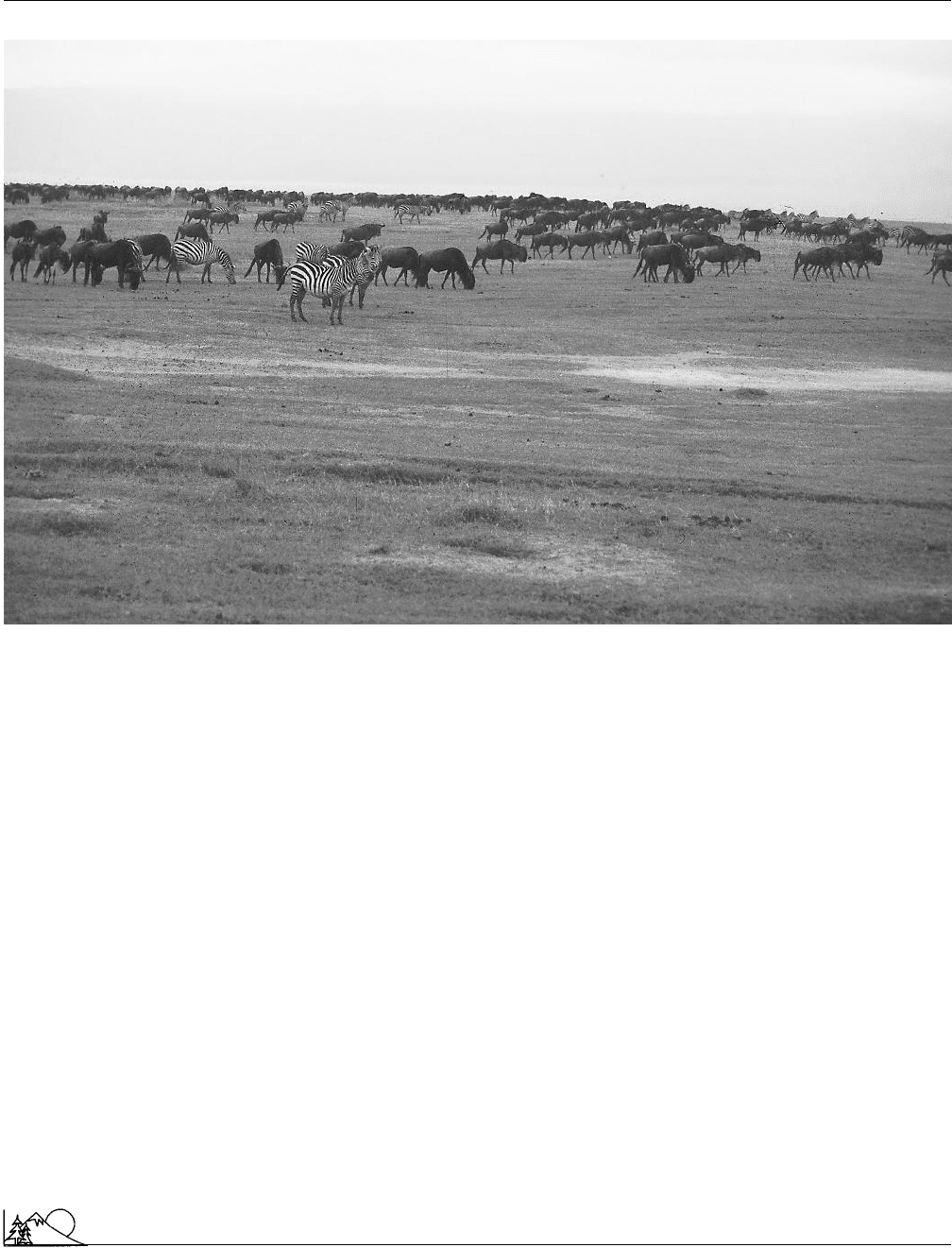Environmental Encyclopedia
Подождите немного. Документ загружается.


Environmental Encyclopedia 3
Yucca Mountain
focal point in the controversy of whether we are “loving our
parks to death.” People and traffic management has become
as critical as traditional resource management. At Yosemite,
balancing the public’s needs and desires with the protection
of the
natural resources
is the National Park Service’s
greatest challenge as they enter the twenty-first century.
[Ted T. Cable]
R
ESOURCES
B
OOKS
Frome, M. National Park Guide. 19th ed. Chicago: Rand McNally, 1985.
O
THER
Yosemite 1992 Fact Sheet. National Park Service, U. S. Department of
Interior, 1992.
O
RGANIZATIONS
Yosemite National Park, P.O. Box 577, Yosemite National Park, CA 20240
(209) 372-0200, Email: comments@yosemite.com, <http://
www.yosemitepark.com>
National Park Service, 1849 C Street NW, Washington, D.C. 20240
(202) 208-6843, <http://www.nps.gov>
Yucca Mountain
Yucca Mountain is a barren
desert
ridge about 90 mi (161
km) northwest of Las Vegas, Nevada. The
U.S. Department
of Energy
plans to build its first high-level nuclear waste
storage facility there in an extensive series of tunnels deep
beneath the desert surface. Choosing this site has been a
long and divisive process. Although over 20 years and more
than $7 billion have been spent designing and testing the
storage facility, scientists are still not clear whether the facil-
ity will remain dry and stable for the thousands of years it
will take for natural decay processes to make the wastes less
radioactive.
Most of the nuclear waste to be stored at Yucca Moun-
tain will come from nuclear
power plants
. As radioactive
uranium
235 is consumed in fission reactions, the fuel be-
comes depleted and accumulating waste products reduce
energy production. Every year about one-third of the fuel
in a typical reactor must be removed and replaced with a
fresh supply. The spent (depleted) fuel must be handled and
stored very carefully because it contains high concentrations
of dangerous radioactive elements, in addition to natural
uranium, thorium, and
radon
isotopes. Some of these mate-
rials have very long half-lives, requiring storage for at least
10,000 years before their
radioactivity
is reduced to harm-
less levels by natural decay processes.
Originally, the United States intended to reprocess
spent fuel to extract and purify unused uranium and
pluto-
nium
as fuel for advanced breeder reactors (a type of nuclear
reactor). Reprocessing plants released unacceptable amounts
1547
of radioactivity, however, and breeder reactors proved to be
too expensive and dangerous to serve as civilian power
sources. For a time in the 1950s, nuclear wastes were dumped
in the ocean, but that practice was stopped when it was
discovered that the corroding metal waste containers allow
radio-isotopes to dissolve in seawater.
In 1982, the U.S. Congress ordered the Department of
Energy (DOE) to build two sites for permanent
radioactive
waste
disposal on land by 1998. Understandably, no one
wanted this toxic material in their backyard. In 1987, after
a long and highly contentious process, the DOE announced
that it could only find one acceptable site: Yucca Mountain.
The storage facility would be a honeycomb of tunnels
more than 1,000 ft (303.3 m) below ground. When finished,
the total length of the tunnels would be more than 112
mi (180 km)—approximately the size of the world’s largest
subway system in New York City. Altogether, the tunnels
would have room for more than 80,000 tons of nuclear waste
packed in corrosion-resistant metal canisters. Because Yucca
Mountain is located in one of the driest areas in the United
States, and the bedrock is composed of highly stable volcanic
tuff (compacted ash), the DOE hopes that storage areas will
remain intact and free of leaks for the thousands of years it
will take for the wastes to decay to a harmless state. Total
costs for this facility have been estimated to be as high as
$58 billion for construction and the first 50 years operation.
Ever since its designation as the nation’s sole repository
for high-level nuclear waste, Yucca Mountain has been em-
broiled in both scientific and political controversy. Citizens
of Nevada feel that their state was chosen only because they
don’t have the political clout to resist. Ironically, Nevada
doesn’t have a
nuclear power
plant. State officials and the
Nevada Congressional delegation have vowed to do every-
thing in their power to try to stop construction and operation
of the nuclear waste facility.
Scientists are divided about the safety of the site. Al-
though some studies suggest that Yucca Mountain has been
geologically stable for thousands of years, others show a
history of fairly recent volcanic activity and large earthquakes
in the area. Fractures and faults have been discovered in the
bedrock that could allow ground water to seep into storage
vaults if the
climate
changes. One hydrologist suggested
that
groundwater
levels, while low now, could rise suddenly
and fill the tunnels with water. Opponents of the site claim
that over 200 technical problems had not been solved by
the DOE by 2002.
The storage project has been continually delayed. After
over $1 billion had been spent on exploratory studies and
trial drilling at Yucca Mountain, the DOE announced in
1986 that it could not meet the 1998 deadline imposed by
Congress. The earliest date by which the repository might
be operational is now 2010. States and power companies,

Environmental Encyclopedia 3
Yucca Mountain
having already paid more than $12 billion to the DOE to
build the repository, have threatened to sue the government
if it does not open as originally promised. Some utilities
have begun to negotiate privately with Native American
tribes and foreign countries to take their nuclear wastes.
While underground storage of nuclear wastes is
fraught with problems and uncertainties, none of the alterna-
tives now available appears better. Currently, about 45,000
tons of spent fuel is sitting at 131 sites, including 103 op-
erating nuclear plants, in 39 states. Another 20,000 tons are
expected to be generated before a storage facility can be
opened in 2010, or about 2,000 tons of new waste per year.
Most of this waste is being stored in deep water-filled pools
inside nuclear plants. These pools were never intended for
long-term storage and are now over-crowded. Many power
plants have no more room for spent fuel storage and will be
forced to shut down by 2010 unless some form of long-term
storage is approved. In 1997, the DOE asked Congress for
$100 million to purchase large steel casks in which power
companies can stockpile spent fuel assemblies in outdoor
storage yards. Neighbors who live near these storage sites
worry about the possibility of leakage and accidents. Never-
theless, several utilities have already begun on-site
dry cask
storage
. It is estimated that 165 million Americans live
within a two-hour drive of stored high-level nuclear waste.
In February 2002, under the recommendation of En-
ergy Secretary Spencer Abraham, President George W. Bush
approved Yucca Mountain as the nation’s nuclear waste stor-
age site, to be opened in 2010. It would receive a minimum
of 3,000 tons of nuclear waste per year for 23 years, storing
up to a legal maximum of 77,000 tons. After 2007, another
energy secretary may consider expanding the storage facility.
As expected, and as allowed by federal law, the state
of Nevada filed a formal objection to the site approval. In
May 2002 the U.S. House of Representatives voted to over-
ride Nevada’s objections to the site. A major political battle
was then taken to the U.S. Senate, which had until July 26,
2002 to decide upon the future of U.S. nuclear waste dis-
posal. In July 2002 the site was approved.
The nuclear power industry is the main supporter of
the storage site, in order to continue producing nuclear en-
1548
ergy, which supplies about 20% of U.S. electricity. Oppo-
nents of the site claim that long-term storage and
transpor-
tation
of the waste is far too dangerous, given inconclusive
scientific studies. Furthermore, if nuclear power is continued,
opponents note that Yucca Mountain will eventually run
out of space and the nuclear waste problem will still be
unsolved.
Waste storage at Yucca Mountain is a complex, expen-
sive, and potentially high-risk problem that exemplifies the
complications of many environmental issues. It also demon-
strates the difficulty of making democratic decisions in issues
with consequences that affect large geographical areas and
future generations
in ways that are difficult to predict and
potentially control.
[William P. Cunningham Ph.D. and Douglas Dupler]
R
ESOURCES
B
OOKS
Gerrard, Michael B. Fairness in Toxic and Nuclear Waste Siting. Cambridge,
MA: MIT Press, 1994.
Rahm, Dianne, ed. Toxic Waste and Environmental Policy in the Twenty-
first Century United States. Jefferson, NC: McFarland & Co., 2002.
Shrader-Frechette, K. S. Burying Uncertainty: Risk and the Case Against
Geological Disposal of Nuclear Waste. Berkeley: University of California
Press, 1994.
Streissguth, Thomas, ed. Nuclear and Toxic Waste. San Diego, CA:
Greenhaven Press, 2001.
P
ERIODICALS
“Battle of Yucca Mountain.” Washington Post, April 30, 2002: A18.
“How Safe is Safe?” Christian Science Monitor April 18, 2002: 14.
Kerr, R. A. “A New Way to Ask the Experts: Rating Radioactive Waste
Risks.” Science November 8, 1996: 913.
Whipple, C. G. “Can Nuclear Waste be Stored Safely at Yucca Mountain?”
Scientific American 274, no. 6: 72–77.
O
THER
Environmental Protection Agency. Yucca Mountain Standards. June 19,
2002 [cited July 4, 2002]. <http://www.epa.gov/radiation/yucca/in-
dex.html>.
O
RGANIZATIONS
U.S. Department of Energy, 1000 Independence Avenue SW, Washington,
DC 20585 (202) 586-6151, Fax: (202) 586-0956, <http://www.doe.gov>
Yucca Mountain Project, PO Box 364629, North Las Vegas, NV 89036-
8629 (800) 225-6972, Fax: (702) 295-5222, <http://www.ymp.gov>

Z
Zebra mussel
The zebra mussel (Dreissena polymorpha) is a small bivalve
mollusk native to the freshwater rivers draining the Caspian
and Black Seas of western Asia. This
species
of shellfish,
which gets its name from the dark brown stripes on its tan
shell, was introduced into the
Great Lakes
of the United
States and Canada and became established sometime be-
tween 1985 and 1988.
The zebra mussel was first discovered in North
America in June of 1988 in the waters of Lake St. Clair.
The introduction probably took place two or three years
prior to the discovery, and it is believed that a freighter
dumped its ballast water into Lake St. Clair, flushing the
zebra mussel out in the process. By 1989 this mussel had
spread west through Lake Huron into Lake Michigan and
east into
Lake Erie
. Within three years it had spread to all
five of the Great Lakes.
Unlike many of its other freshwater relatives, which
burrow into the sand or
silt
substrate of their
habitat
, the
zebra mussel attaches itself to any solid surface. This was
the initial cause for concern among environmentalists as
well as the general public; these mollusks were attaching
themselves to boats, docks, and water intake pipes. Zebra
mussels also reproduce quickly, and they can form colonies
with densities of up to 100,000 individuals per square meter.
The city of Monroe, Michigan, lost its water supply for two
days because its intake pipes were plugged by a huge colony
of zebra mussels, and Detroit Edison spent half a million
dollars cleaning them from the cooling system of its Monroe
power plant. Ford Motor Company was forced to close its
casting plant in Windsor, Ontario, in order to remove a
colony from the pipes which send cooling water to their
furnaces.
Although the sheer number of these filter feeders has
actually improved
water quality
in some areas, they still
pose threats to the ecological
stability
of the aquatic
ecosys-
tem
in this region. Zebra mussels are in direct
competition
with native mussel species for both food and oxygen. Several
1549
Zebra mussel. (Michigan Sea Grant Society. Repro-
duced by permission.)
colonies have become established on the spawning grounds
of commercially important species of fish, such as the wall-
eye, reducing their reproductive rate. The zebra mussel feeds
on algae, and this may also represent direct competition with
several species of fishes.
The eradication of the zebra mussel is widely consid-
ered an impossible task, and environmentalists maintain
that this species will now be a permanent member of the
Great Lakes ecosystem. Most officials in the region agree
that money would be wasted battling the zebra mussel,
and they believe that it is more reasonable to accept their
presence and concentrate on keeping intake pipes and
other structures clear of the creatures. The zebra mussel
has very few natural predators, and since it is not considered
an edible species, it has no commercial value to man.
One enterprising man from Ohio has turned some zebra
mussel shells into jewelry, but currently the supply far
exceeds the demand.
[Eugene C. Beckham]

Environmental Encyclopedia 3
Zebras
R
ESOURCES
P
ERIODICALS
Griffiths, R. W., et al. “Distribution and Dispersal of the Zebra Mussel
(Dreissena polymorpha) in the Great Lakes Region.” Canadian Journal of
Fisheries and Aquatic Science 48 (1991): 1381–1388.
Holloway, M. “Musseling In.” Scientific American 267 (October 1992):
30–36.
Schloesser, D. W., and W. P. Kovalak. “Infestation of Unionids by Dreissena
polymorpha in a Power Plant Canal in Lake Erie.” Journal of Shellfish Research
10 (1991): 355–359.
Walker, T. “Dreissena Disaster.” Science News 139 (May 4, 1991): 282–284.
Zebras
Zebras are striped members of the horse family (Equidae)
native to Africa. These grazing animals stand 4–5 ft (1.2–
1.5 m) high at the shoulders and are distinctive because of
their striking white and black or dark brown stripes running
alternately throughout their bodies. These stripes actually
have important survival value for zebras, for when they are
in a herd, the stripes tend to blend together in the bright
African sunlight, making it hard for a lion or other predator
to concentrate on a single individual and bring it down.
The zebra’s best defense is flight, and it can outrun
most of its enemies. It is thus most comfortable grazing and
browsing in groups on the flat open plains and
grasslands
.
Zebras are often seen standing in circles, their tails swishing
away flies, each one facing in a different direction, alert for
lions or other predators hiding in the tall grass.
Most zebras live on the grassy plains of East Africa,
but some are found in mountainous areas. They live in small
groups led by a stallion, and mares normally give birth to a
colt every spring. Zebras are fierce fighters, and a kick can
kill or cripple predators (lions, leopards, cheetahs, jackals,
hyenas, and wild dogs). These predators usually pursue new-
born zebras, or those that are weak, sick, injured, crippled,
or very old, as those are the easiest and safest to catch and
kill. Such predation helps keep the
gene pool
strong and
healthy by eliminating the weak and diseased and ensuring
the “survival of the fittest.”
Zebras are extremely difficult to domesticate, and most
attempts to do so have failed. They are often found grazing
with wildebeest, hartebeest, and gazelle, since they all have
separate nutritional requirements and do not compete with
each other. Zebras prefer the coarse, flowering top layer of
grasses, which are high in cellulose. Their trampling and
grazing are helpful to the smaller wildebeest, who eat the
leafy middle layer of grass that is higher in protein. And the
small gazelles feed on the protein-rich young grass, shoots,
and herb blossoms found closest to the ground.
One of the most famous African
wildlife
events is
the seasonal 800-mi (1,287-km)
migration
in May and
1550
November of over a million zebras, wildebeest, and gazelles,
sweeping across the Serengeti plains, as they have done for
centuries, “in tides that flow as far as the eye can see.” But
it is now questionable how much longer such scenes will
continue to take place.
Zebras were once widespread throughout southern and
east Africa, from southern Egypt to Capetown. But
hunting
for sport, meat, and hides has greatly reduced the zebra’s
range and numbers, though it is still relatively numerous in
the parks of East Africa. One
species
, once found in South
Africa, the quagga (Equus quagga quagga) is already extinct,
wiped out by colonists in search of hides to make grain sacks.
Several other species of zebra are threatened or endan-
gered, such as Grevy’s zebra (Equus grevyi) in Kenya, Ethio-
pia, and Somalia; Hartmann’s mountain zebra (Equus zebra
hartmannae) in Angola and Namibia; and the mountain
zebra (Equus zebra zebra) in South Africa. The Cape moun-
tain zebra has adapted to life on sheer mountain slopes and
ravines where usually only wild goats and sheep can survive.
In 1964, only about 25 mountain zebra could be found in
the area, but after two decades of protection, the population
had increased to several hundred in Cradock
National Park
in the Cape Province’s Great Karroo area.
Probably the biggest long-term threat to the survival
of the zebra is the exploding human population of Africa,
which is growing so rapidly that it is crowding out the
wildlife and intruding on the continent’s parks and refuges.
Political instability and the proliferation of high powered
rifles in many countries also represent a threat to the survival
of Africa’s wildlife.
[Lewis G. Regenstein]
R
ESOURCES
P
ERIODICALS
D’Alessio, V. “Born-Again Quagga Defies Extinction.” New Scientist 132
(November 30, 1991): 14.
Grubb, P. “Equus burchelli.” Mammalian Species no. 157, 1981.
Miller, J. A. “Telling a Quagga By Its Stripes.” Science News 128 (August
3, 1985): 70.
Penzhorn, B. L. “Equus zebra.” Mammalian Species no. 314, 1988.
Zero discharge
Zero
discharge
is the goal of eliminating discharges of
pollutants by industry, government, and other agencies to
air, water, and land with a view to protect both public health
and the integrity of the
environment
. Such a goal is difficult
to achieve except where there are point sources of
pollution
,
and even then the cost of removing the last few percent of

Environmental Encyclopedia 3
Zero population growth
Zebras and wildebeasts at Ngorongoro Crater, Serengeti National Park, Tanzania. (Photograph by Carolina Biological
Supplies. Phototake. Reproduced by permission.)
a given pollutant may be prohibitive. However, the goal is
attainable in many specific cases (e.g., the electroplating
industry), and is particularly urgent in the case of extremely
toxic pollutants such as
plutonium
and dioxins. In other
cases, it may be desirable as a goal even though it is not
likely to be completely attained.
Zero discharge was actually proposed in the early
1970s by the United States Senate as an attainable goal for
the Federal
Water Pollution
Control Acts Amendments of
1972. However, industry, the White House, and other
branches of government lobbied intensely against it, and
the proposal did not survive the legislative process. See
also Air quality criteria; Pollution control; Water quality
standards
Zero population growth
Zero
population growth
(also called the replacement
level of fertility) refers to stabilization of a population at
its current level. A population growth rate of zero means
1551
that people are only replacing themselves, and that the
birth and death rates over several generations are in
balance. In more developed countries (MDC), where infant
mortality
rates are low, a fertility rate of about 2.2 children
per couple results in zero population growth. This rate
is slightly more than two because the extra fraction includes
infant deaths, infertile couples, and couples who choose
not to have children. In
less developed countries
(LDC),
the replacement level of fertility is often as high as six
children per couple.
Zero population growth, as a term, lends its name to
a national, non-profit organization founded in 1968 by Paul
R. Ehrlich, which works to achieve a sustainable balance
between population, resources, and the
environment
world-
wide. See also Family planning
R
ESOURCES
O
RGANIZATIONS
Zero Population Growth, 1400 16th Street NW, Suite 320, Washington,
D.C. 20036

Environmental Encyclopedia 3
Zero risk
Zero risk
A concept allied to, but less stringent than, that of
zero
discharge
. Zero risk permits the release to air, water, and
land of those pollutants that have a
threshold dose
below
which public health and the
environment
remain undam-
aged. Such thresholds are often difficult to determine. They
may also involve a time element, as in the case of damage
to vegetation by
sulfur dioxide
in which less severe fumiga-
tions over a longer period are equivalent to more severe
exposures over a shorter period. See also Air quality criteria;
Pollution control; Water quality standards
Zone of saturation
In discussions of
groundwater
, a zone of saturation is an
area where water exists and will flow freely to a well, as it
does in an
aquifer
. The thickness of the zone varies from a
few feet to several hundred feet, determined by local geology,
availability of pores in the formation, and the movement of
water from recharge to points of
discharge
.
Saturation can also be a transient condition in the
soil
profile
or
vadose zone
during times of high precipitation
or
infiltration
. Such saturation can vary in duration from a
few days or weeks to several months. In soils, the saturated
zone will continue to have unsaturated conditions both above
and below it; when a device used to measure saturation,
called a piezometer, is placed in this zone, water will enter
and rise to the depth of saturation. During these periods,
the
soil
pores are filled with water, creating reducing condi-
tions due to lowered oxygen levels. This reduction, as well
as the movement of iron and manganese, creates distinctive
soil patterns that allow the identification of saturated condi-
tions even when the soil is dry. See also Artesian well; Drink-
ing-water supply
Zoo
Zoos are institutions for exhibiting and studying wild ani-
mals. Many contemporary zoos have also made
environ-
mental education
and the
conservation
of
biodiversity
part of their mission. “Zoo” is a term derived from the Greek
zoion, meaning “living being.” As a prefix it indicates the
topic of animals, such as in zoology (knowledge of animals)
or zoogeography (the distribution and evolutionary
ecology
of animals). As a noun it is a popular shorthand for all
zoological gardens and parks.
Design and operation
Zoological gardens and parks are complex institutions
involving important factors of design, staffing, economics,
and politics. Design of a zoo is a compromise between the
1552
needs of the animals (e.g., light, temperature, humidity,
cover, feeding areas, opportunities for natural behavior), the
requirements of the staff (e.g., offices, libraries, research and
veterinary laboratories, garages, storage sheds), and ame-
nities for visitors (e.g., information, exhibitions, restaurants,
rest areas, theaters,
transportation
).
Zoos range in size from as little as 2 acres (0.8 ha) to
as much as 3,000 acres (1,231 ha), and animal enclosures
may range from small cages to fenced-in fields. The proper
size for each enclosure is determined by many factors, includ-
ing the kind and number of
species
being exhibited and
the extent of the enclosure’s natural or naturalistic landscap-
ing. In small zoos, space is at a premium. Cages and paddocks
are often arranged into taxonomic or zoogeographic pavil-
ions, with visitors walking among the exhibits. As a collec-
tion of animals in a confined and artfully arranged space,
these zoos are called zoological gardens. In larger zoos, more
space is generally available. Enclosures may be bigger, the
landscaping more elaborate, and cages fewer in number.
Nonpredatory species such as hoofed mammals may roam
freely within the confines of the zoo’s outer perimeter. Visi-
tors may walk along raised platforms or ride monorail trains
through the zoo. Lacking the confinement and precise ar-
rangement of a garden, these zoos are called zoological parks.
Some zoos take go a step farther and model themselves after
Africa’s national parks and
game preserves
. Visitors drive
cars or ride buses through these “safari parks,” observing
animals from vehicles or blinds.
A zoo’s many functions are reflected in its staff, which
is responsible for the animals’ well-being, exhibitions, envi-
ronmental education, and conservation programs. There are
several job categories: administrators, office personnel, and
maintenance staff tend to the management of the institution.
Curators are trained
wildlife
biologists responsible for ani-
mal acquisition and transfer, as well as maintaining high
standards of animal care. Keepers perform the routine care of
the animals and the upkeep of their enclosures. Veterinarians
focus on preventive and curative medicine, guard against
contagious disease, heal stress-induced ailments or accidental
injuries, and preside over births and autopsies. Well-trained
volunteers serve as guides and guards, answering questions
and monitoring visitor conduct. Educators and scientists
may also be present for the purpose of environmental educa-
tion and research.
Zoos are expensive undertakings, and their economy
enables or constrains their resources and practices. Few good
zoos produce surplus revenue; their business is service, not
profit. Most perpetually seek new sources of capital from
both public and private sectors, including government sub-
sidies, admission charges, food and merchandise sales, con-
cessionaire rental fees, donations, bequests, and grants. The
funds are used for a variety of purposes, such as daily opera-

Environmental Encyclopedia 3
Zoo
tions, animal acquisitions, renovations, expansion, public ed-
ucation, and scientific research. The precise mixture of public
and private funds is situational. As a general rule, public
money provides the large investments needed to start, reno-
vate, or expand a zoo. Private funds are better suited for
small projects and exhibit startup costs.
A variety of public and private interests claim a stake
in a zoo’s mission and management. Those concerned with
the politics of zoos include units of government, regulatory
agencies, commercial enterprises, zoological societies, non-
profit foundations, activist groups, and scholars. They influ-
ence the availability and use of zoo resources by holding the
purse strings and affecting public opinion. Conflict between
the groups can be intense, and ongoing disputes over the
use of zoos as entertainment, the acquisition of “charismatic
megafauna” (big cute animals), and the humane treatment
of wildlife are endemic.
History and purposes
Zoos are complex cultural phenomena. Menageries,
the unsystematic collections of animals that were the progen-
itors of zoos, have a long history. Particularly impressive
menageries were created by ancient societies. The Chinese
emperor Wen Wang (circa 1000
B.C.
) maintained a 1,500
acre (607 ha) “Garden of Intelligence.” The Greek philoso-
pher Aristotle (384-322
B.C.
) studied animal taxonomy from
a menagerie stocked largely through the conquests of Alex-
ander the Great (356-323
B.C.
). Over 1,200 years later, the
menagerie of the Aztec ruler Montezuma (circa
A.D.
1515)
rivaled any European collection of the sixteenth century.
In the main, these menageries had religious, recre-
ational, and political purposes. Ptolemy II of Egypt (300-
251
B.C.
) sponsored great processions of exotic animals for
religious festivals and celebrations. The Romans maintained
menageries of bears,
crocodiles
,
elephants
, and lions for
entertainment. Powerful lords maintained and exchanged
wild and exotic animals for diplomatic purposes, as did Char-
lemagne (
A.D.
768-814), the medieval king of the Franks.
Dignitaries gawked at tamed cheetahs strolling the botanical
gardens of royal palaces in Renaissance Europe. Indeed,
political and social prestige accrued to the individual or
community capable of acquiring and supporting an elaborate
and expensive menagerie.
In Europe, zoos replaced menageries as scholars turned
to the scientific study of animals. This shift occurred in
the eighteenth century, the result of European voyages of
discovery and conquest, the founding of natural history mu-
seums, and the donation of private menageries for public
display. Geographically representative species were collected
and used to study natural history, taxonomy, and physiology.
Some of these zoos were directed by the outstanding minds
of the day. The French naturalist Georges Leopold Cuvier
(1769-1832) was the zoological director of the Jardin de
1553
Plants de Paris (founded in 1793), and the German geogra-
pher Alexander von Humboldt (1769-1859) was the first
director of the Berlin Zoological Garden (founded in 1844).
The first zoological garden for expressly scientific purposes
was founded by the Zoological Society of London in 1826;
its establishment marks the advent of modern zoos.
Despite their scientific rhetoric, zoological gardens and
parks retained their recreational and political purposes. Late
nineteenth century visitors still baited bears, fed elephants,
and marveled at the exhausting diversity of life. In the United
States, zoos were regarded as a cultural necessity, for they
reacquainted harried urbanites with their
wilderness
fron-
tier heritage and proved the natural and cultural superiority
of North America. As if
recreation
, politics, and science
were not enough, an additional element was introduced in
North American zoos: conservation. North Americans had
succeeded in decimating much of the continent’s wildlife,
driving the
passenger pigeon
(Ectopistes migratorius)to
extinction
, the American
bison
(Bison bison) to endanger-
ment, and formerly common wildlife into rarity. It was be-
lieved that zoos would counteract this wasteful slaughter of
animals by promoting their wise use. At present, zoos claim
similar purposes to explain and justify their existence, namely
recreation, education, and conservation.
Evaluating zoos
Critics of zoos contend they are antiquated, counter-
productive, and unethical; that field ecology and
wildlife
management
make them unnecessary to the study and
conservation of wildlife; and that zoos distort the public’s
image of
nature
and animal behavior, imperil rare and en-
dangered wildlife for frivolous displays, and divert attention
from saving natural
habitat
. Finally, critics hold that zoos
violate humans’ moral obligations to animals by incarcerating
them for a trivial interest in recreation. Advocates counter
these claims by insisting that most zoos are modern, neces-
sary, and humane, offering a form of recreation that is benign
to animal and human alike and is often the only viable place
from which to conduct sustained behavioral, genetic, and
veterinary research.
Zoos are an important part of environmental educa-
tion. Indeed, some advocates have proposed “bioparks” that
would integrate aquariums, botanical gardens, natural history
museums, and zoos. Finally, advocates claim that animals in
zoos are treated humanely. By providing for their nutritional,
medical, and security needs, zoo animals live long and digni-
fied lives, free from hunger, disease, fear, and predation.
The arguments of both critics and advocates have
merit, and in retrospect, zoos have made substantial progress
since the turn of the century. In the early 1900s, many
zoos collected animals like postage stamps, placing them in
cramped and barren cages with little thought to their com-
fort. Today, zoos increasingly use large naturalistic enclo-

Environmental Encyclopedia 3
Zooplankton
sures and house social animals in groups. They often special-
ize in zoogeographic regions, permitting the creation of
habitats which plausibly simulate the
climate
,
topography
,
flora
, and
fauna
of a particular
environment
. Additionally,
many zoos contribute to the protection of biodiversity by
operating captive-breeding programs, propagating
endan-
gered species
, and restoring destroyed species to suitable
habitat.
This progress notwithstanding, zoos have limitations.
Statements that zoos are “arks” of biodiversity, or that zoos
teach people how to manage the “megazoo” called nature,
greatly overstate their uses and lessons. Zoos simply cannot
save, manage, and reconstruct nature once its genetic, spe-
cies, and habitat diversity is destroyed. That said, the promo-
tion by zoos of environmental education and biodiversity
conservation is an important role in the defense of the natural
world.
[William S. Lynn]
R
ESOURCES
B
OOKS
Croke, V. The Modern Ark: The Story of Zoos: Past, Present, and Future.
Collingdale: DIANE Publishing Co., 2000.
McKenna, V., W. Travers, and J. Wray, eds. Beyond the Bars: The Zoo
Dilemma. Northamptonshire, UK: Thorsons Publishing Group, 1988.
1554
Page, J. Zoo: The Modern Ark. New York: Facts On File, 1990.
P
ERIODICALS
Foose, T. J. “Erstwild & Megazoo.” Orion Nature Quarterly 8 (Spring
1989): 60–63.
Robinson, M. H. “Beyond the Zoo: The Biopark.” Defenders 62 (November-
December 1987): 10–17.
Stott, J. R. “The Historical Origins of the Zoological Park in American
Thought.” Environmental Review 5 (Fall 1981): 52–65.
Zooplankton
Aquatic animals and protozoans whose movements are
largely dependent upon currents. This diverse assemblage
includes organisms that feed on bacteria,
phytoplankton
,
and other zooplankton, as well as organisms that may not
feed at all. Zooplankton may be divided into holoplankton,
organisms which spend their entire lives as
plankton
, such
as
krill
, and meroplankton, organisms that exist in the plank-
ton for only part of their lives, such as crab larvae. Fish may
live their entire lives in the water column, but are only
classified as zooplankton while in their embryonic and larval
stages.
ZPG
see
Environmental Stress Index

Historical Chronology
1798 Essay on the Principle of Population published by
Thomas Robert Malthus, in which he warned about
the dangers of unchecked population growth.
1830 World population is one billion.
1849 U.S. Department of the Interior established.
1854 Henry David Thoreau publishes Walden, a work
that inspired many people to live simply and in
harmony with nature.
1864 Yosemite in California becomes the first state park
in the United States.
1864 George Perkins Marsh publishes Man and Nature,
described by some environmentalists as the foun-
tainhead of the conservation movement.
1869
Ernst Haeckel coins the term ecology to describe
“the body of knowledge concerning the economy
of nature.”
1872
Yellowstone in Wyoming becomes the first na-
tional park.
1875
American Forestry Association founded to encour-
age wise forest management.
1879
U.S. Geological Survey established.
1890
Yosemite becomes a national park.
1892
John Muir founds the Sierra Club to preserve the
Sierra Nevada mountain chain.
1892
Henry S. Salt publishes Animal Rights Considered
in Relation to Social Progress, a landmark work on
animal rights and welfare.
1555
1892 Adirondack Park established by New York State
Constitution, which mandated that the region re-
main forever wild.
1898 Rivers and Harbors Act established in an effort to
control pollution of navigable waters.
1900 Lacey Act regulating interstate shipment of wild
animals in the United States is passed.
1902 U.S. Bureau of Reclamation established.
1905 National Audubon Society formed.
1908 Chlorination is used extensively in U.S. water treat-
ment plants for the first time.
1913 Construction of Hetch-Hetchy Valley Dam ap-
proved to provide water to San Francisco; however,
the dam also floods areas of Yosemite National
Park.
1914 Martha, the last passenger pigeon, dies in the Cin-
cinnati Zoo.
1916 United States National Park Service established.
1918 Save-the-Redwoods League founded.
1918 U.S. and Canada sign treaty restricting the hunting
of migratory birds.
1920 Mineral Leasing Act enacted to regulate mining
on federal land.
1922 Izaak Walton League founded.
1924 Gila National Forest in New Mexico is designated
the first wilderness area.
1930 Dust Bowl.

Environmental Encyclopedia 3
Historical Chronology
1933 Tennessee Valley Authority created to assess impact
of hydropower on the environment.
1934 Taylor Grazing Act enacted to regulate grazing on
federal land.
1935 U.S. Soil Conservation Service established to study
and curb soil erosion.
1935 Wilderness Society founded by Aldo Leopold.
1936 National Wildlife Federation established.
1943 Alaska Highway completed, linking lower United
States and Alaska.
1944 Norman Borlaug begins his work on high-yielding
cropvarieties.
1946 U.S. Bureau of Land Management created.
1946 Atomic Energy Commission established to study
the applications of nuclear power. It was later
dissolved in 1975, and its responsibilities were
transferred to the Nuclear Regulatory Commission
and Energy Research and Development Adminis-
tration.
1947 Defenders of Wildlife founded, superseding De-
fenders of Furbearers and the Anti-Steel-Trap
League, to protect wild animals and their habitat.
1949 Aldo Leopold publishes A Sand CountyAlmanac,
in which he sets guidelines for the conservation
movement and introduces the concept of a land
ethic.
1952 Oregon becomes first state to adopt a significant
program to control air pollution.
1954 Humane Society founded in United States.
1956 Construction of Echo Park Dam on the Colorado
River is aborted, due in large part to the efforts of
environmentalists.
1959 St. Lawrence Seaway is completed, linking the At-
lantic Ocean to the Great Lakes.
1961 Agent Orange is sprayed in Southeast Asia,
exposing nearly 3 million American servicemen to
dioxin, a probable carcinogen.
1962 Silent Spring published by Rachel Carson to docu-
ment the effects of pesticides on the environment.
1556
1963 First Clean Air Act passed in the United States.
1963 Nuclear Test Ban Treaty signed by the United
States and the Soviet Union to stop atmospheric
testing of nuclear weapons.
1964 Wilderness Act passed, which protects wild areas
in theUnited States.
1965 Water Quality Act passed, establishing federal
water quality standards.
1966 Eighty people die in New York City due to pollu-
tion-related causes.
1967 Supertanker Torrey Canyon spills oil off the coast
of England.
1967 Environmental Defense Fund established to save
the osprey from DDT.
1967 American Cetacean Society founded to protect
whales, dolphins, porpoises, and other cetaceans.
Considered the oldest whale conservation group in
the world.
1968 Wild and Scenic Rivers Act and National Trails
System Act passed to protect scenic areas from
development.
1969 Greenpeace founded.
1970 First Earth Day celebrated on April 22.
1970 National Environmental Policy Act passed, requir-
ing environmental impact statements for projects
funded or regulated by federal government.
1970 Environmental Protection Agency (EPA) created.
1971 Consultative Group on International Agricultural
Research (CGIAR) founded to improve food pro-
duction in developing countries.
1972 U.N. Conference on the Human Environment held
in Stockholm to address environmental issues on a
global level.
1972 Clean Water Act passed.
1972 Use of DDT is phased out in the United States.
1972 Coastal Zone Management Act and Marine Pro-
tection, Research, and Sanctuaries Act passed.
